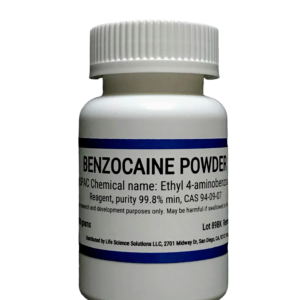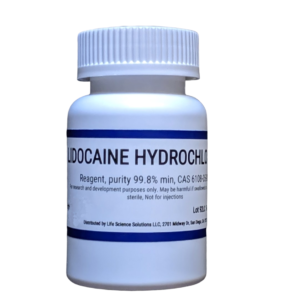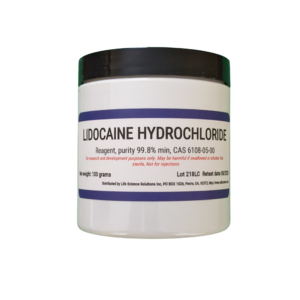-
Sale!

Benzocaine Powder, 99.9%, 100 grams
Original price was: $34.95.$24.50Current price is: $24.50. -
Sale!

Benzocaine Powder, 99.9%, 10 grams
Original price was: $13.98.$10.75Current price is: $10.75. -
Sale!

Lidocaine powder – Lidocaine HCl, reagent, 50 grams
Original price was: $29.99.$28.75Current price is: $28.75. -
Sale!

Lidocaine powder, Lidocaine HCl, reagent, 99.9%, 10 grams
Original price was: $12.98.$10.75Current price is: $10.75. -
Sale!

Benzocaine Powder, High Purity, 99%+, EP/USP quality
$8.75 – $160.00 -
Sale!

Lidocaine powder – Lidocaine HCl, reagent, purity 99.9%, 25 grams
Original price was: $22.98.$20.75Current price is: $20.75. -
Sale!

Benzocaine Powder, 99.9%, 500 grams
Original price was: $155.00.$110.00Current price is: $110.00. -
Sale!

Lidocaine Hydrochloride, purity 99.9%, 100 grams
Original price was: $42.95.$38.75Current price is: $38.75. -
Sale!

Benzocaine Powder, 99.9%, 25 grams
Original price was: $13.98.$11.75Current price is: $11.75. -
Sale!

Benzocaine powder, 99.9 %, 50 grams
Original price was: $32.99.$22.75Current price is: $22.75. -
Sale!

Lidocaine powder – Lidocaine HCl, purity 99.9%, 1000 grams
Original price was: $170.00.$160.00Current price is: $160.00.
Lidocaine powder is usually a HCl salt of Lidocaine
Lidocaine is also known as Lignocaine and Xylocaine.
Chemical name: 2-(Diethylamino)-N-(2,6-dimethylphenyl)acetamide
Lidocaine is a local anesthetic. It is used to relieve nerve pain.
Lidocaine is a synthetic aminoethylamide with local anesthetic and antiarrhythmic properties. Lidocaine stabilizes the neuronal membrane by binding to and inhibiting voltage-gated sodium channels, thereby inhibiting the ionic fluxes required for the initiation and conduction of impulses and affecting local anesthesia. Lidocaine was discovered in 1946 and went on sale in 1948.
Lidocaine is included in the World Health Organization’s List of Essential Medicines.
In 2017, it was the 208th most commonly prescribed medication in the United States, with more than two million prescriptions.
Lidocaine is one of the most commonly used local anesthetics in dentistry. It can be administered in multiple ways, most often as a nerve block or infiltration, depending on the type of treatment carried out and the area of the mouth worked on.
However, not all forms of Lidocaine require prescriptions. Many products are available over-the-counter.
Lidocaine HCL (Lidocaine powder) is the main active ingredient in many ointments, sprays, or gels used to stop itching and pain from certain skin conditions (e.g., scrapes, minor burns, eczema, insect bites) and to treat minor discomfort and itching caused by hemorrhoids and certain other problems of the genital/anal area (e.g., anal fissures, itching around the vagina/rectum). Lidocaine is commonly used in products for temporary pain relief during tattoo and piercing procedures.
Powdered forms of Lidocaine is used in veterinary applications to treat scrapes, minor burns, and bites
Lidocaine is also the most important antiarrhythmic drug; it is used intravenously for the treatment of ventricular arrhythmias (for acute myocardial infarction, digoxin poisoning, cardioversion, or cardiac catheterization) if amiodarone is not available or contraindicated. Lidocaine should be given for this indication after defibrillation, CPR, and vasopressors have been initiated. A routine preventative dose is no longer recommended after myocardial infarction as the overall benefit is not convincing.
Pharmacology
Mechanism of action
Lidocaine alters signal conduction in neurons by prolonging the inactivation of the fast voltage-gated Na+ channels in the neuronal cell membrane responsible for action potential propagation. With sufficient blockage, the voltage-gated sodium channels will not open and an action potential will not be generated. Careful titration allows for a high degree of selectivity in the blockage of sensory neurons, whereas high concentrations also affect other types of neurons.
The same principle applies to this drug’s actions in the heart. Blocking sodium channels in the conduction system, as well as the muscle cells of the heart, raises the depolarization threshold, making the heart less likely to initiate or conduct early action potentials that may cause an arrhythmia.
Pharmacokinetics
When used as an injectable it typically begins working within four minutes and lasts for half an hour to three hours. Lidocaine is about 95% metabolized (dealkylated) in the liver mainly by CYP3A4 to the pharmacologically active metabolites monoethylglycinexylidide (MEGX) and then subsequently to the inactive glycine xylidide. MEGX has a longer half-life than lidocaine but also is a less potent sodium channel blocker. The volume of distribution is 1.1 L/kg to 2.1 L/kg, but congestive heart failure can decrease it. About 60% to 80% circulates bound to the protein alpha1 acid glycoprotein. The oral bioavailability is 35% and the topical bioavailability is 3%.
In general, lidocaine is readily absorbed across mucous membranes and damaged skin but poorly through intact skin The agent is quickly absorbed from the upper airway, tracheobronchial tree, and alveoli into the bloodstream And although lidocaine is also well absorbed across the gastrointestinal tract the oral bioavailability is only about 35% as a result of a high degree of first-pass metabolism After injection into tissues, lidocaine is also rapidly absorbed and the absorption rate is affected by both vascularity and the presence of tissue and fat capable of binding lidocaine in the particular tissues
The concentration of lidocaine in the blood is subsequently affected by a variety of aspects, including its rate of absorption from the site of injection, the rate of tissue distribution, and the rate of metabolism and excretion. Subsequently, the systemic absorption of lidocaine is determined by the site of injection, the dosage is given, and its pharmacological profile. The maximum blood concentration occurs following intercostal nerve blockade followed in order of decreasing concentration, the lumbar epidural space, brachial plexus site, and subcutaneous tissue. The total dose injected regardless of the site is the primary determinant of the absorption rate and blood levels achieved. There is a linear relationship between the amount of lidocaine injected and the resultant peak anesthetic blood levels.
Nevertheless, it has been observed that lidocaine hydrochloride is completely absorbed following parenteral administration, its rate of absorption depending also on lipid solubility and the presence or absence of a vasoconstrictor agent Except for intravascular administration, the highest blood levels are obtained following intercostal nerve block and the lowest after subcutaneous administration
Additionally, lidocaine crosses the blood-brain and placental barriers, presumably by passive diffusion
The elimination half-life of lidocaine is biphasic and around 90 min to 120 min in most patients. This may be prolonged in patients with hepatic impairment (average 343 min) or congestive heart failure (average 136 min). Lidocaine is excreted in the urine (90% as metabolites and 10% as unchanged drug).
Lidocaine is metabolized predominantly and rapidly by the liver, and metabolites and unchanged drugs are excreted by the kidneys. Biotransformation includes oxidative N-dealkylation, ring hydroxylation, cleavage of the amide linkage, and conjugation. N-dealkylation, a major pathway of biotransformation, yields the metabolites monoethylglycinexylidide and glycinexylidide The pharmacological/toxicological actions of these metabolites are similar to but less potent than, those of lidocaine HCl. Approximately 90% of lidocaine HCl administered is excreted in the form of various metabolites, and less than 10% is excreted unchanged The primary metabolite in urine is a conjugate of 4-hydroxy-2,6-dimethylaniline
WHAT ARE THE SIDE EFFECTS ASSOCIATED WITH USING LIDOCAINE?
Common Side effects of Lidocaine include:
-
Low blood pressure (hypotension)
-
Swelling (edema)
-
Redness at the injection site
-
Small red or purple spots on skin
-
Skin irritation
-
Constipation
-
Nausea
-
Vomiting
-
Confusion
-
Dizziness
-
Headache
-
Numbness and tingling
-
Drowsiness
-
Tremor
-
Irritation symptoms (topical products); i.e., redness, swelling
Serious side effects of lidocaine include:
-
Cardiac arrest
-
Abnormal heartbeat
-
Methemoglobinemia
-
Seizures
-
Severe allergic reactions (anaphylaxis)
-
Malignant hyperthermia
References:
- Lidocaine’s negative inotropic and antiarrhythmic actions. Dependence on the shortening of action potential duration and reduction of intracellular sodium activity – The mechanisms by which lidocaine brings about negative inotropic effects and antiarrhythmic actions in the heart have been examined. link
- Topical lidocaine for neuropathic pain in adults: We included randomized, double‐blind studies of at least two weeks’ duration comparing any formulation of topical lidocaine with placebo or another active treatment in chronic neuropathic pain. Participants were adults aged 18 and over. link
- Lidocaine / prilocaine spray for premature ejaculation”. Drug and Therapeutics Bulletin. 55 (4): 45–48. April 2017.
